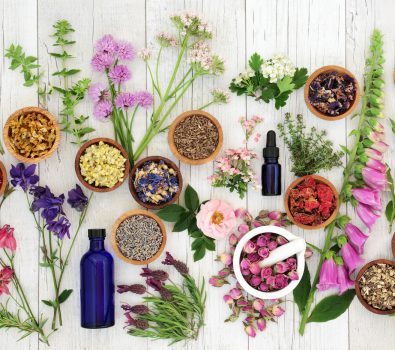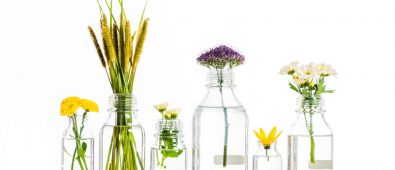COSMETIC CLAYS: LONG-USED IN BODY AND FACE SKIN CARE. SHOULD WE ALSO APPLY THEM TO HAIR?
Today I’m giving you an article that belongs to ‘Natural Beauty Tips’ category – it deals with the issue of cosmetic clays. To be honest with you, I’m just taking my first steps in using cosmetic clays. I’m still learning how mighty they are, however, I’m eager to share with you what I’ve managed to discover so far. Perhaps you too will be surprised at the multitude of uses that cosmetic clays offer as I was.
What are cosmetic clays?
I’ll start with the most important question: What are clays in particular? We know – more or less – how they look like but just few know what they really are. Powdered mud? Well, it appears that cosmetic clays are nothing but natural minerals. In most cases they appear in a powdery form but when combined with water or herbal distillate they become a kind of a muddy pulp that cakes pretty fast.
What do they contain?
It all depends on the type of cosmetic clay you choose. Its chemical constituents depend on the place it was mined from and its type, yet – no matter the type – you will always find bigger or smaller concentration of micro and macro elements. Among the elements you can find: potassium, magnesium, iron, zinc, selenium, calcium, phosphorus and many other. Also, all cosmetic clays are always well-tolerated by skin.
The most common cosmetic clays types
- White clay is ideal to treat dry, delicate and mature skin types because it cleanses, smooths out, nourishes skin; white clay improves blood flow and stimulates skin self-renewal processes.
- Red clay is suitable to treat fatigued, combination and oily face; it can be also used in the case of acne rosacea and varicose veins therefore it effectively regenerates, accelerates wound healing processes and improves blood flow.
- Green clay is the strongest among all cosmetic clays, it perfectly disinfects skin, cleanses, reduces irritations, balances skin’s pH, tonifies; it has a regenerating effect; green clay is also known for reducing cellulite and stretch marks.
- Pink clay is suitable for sensitive, irritated and problematic skin types (e.g. affected by acne, scars, discolorations), therefore it’s really good at cleaning, soothing irritations and fostering skin self-renewal processes.
- Yellow clay is recommended to take care of fatigued, combination and oily skin to restore the balance, bring relief, soothe, nourish and improve skin.
- Blue clay is the best option for dry, delicate and sensitive skin, especially for the skin that is blemished by discolorations and blackheads; blue clay displays regenerating and skin firming properties; it also is highly nourishing.
What are the benefits of using cosmetic clays?
Cosmetic clays, despite producing various effects, they all share a few characteristic properties such as:
- flawlessly absorb impurities
- are recognized as detoxifying substances
- improve blood circulation
- may soothe irritations
- nourish skin
- foster skin self-regeneration processes
- leave skin firm and fresh
Application of cosmetic clays: Body, face, hair
What can you use cosmetic clay for?
In most cases cosmetic clays are used for skin cleansing purposes – as the main ingredient added to face masks and scrubs. Cosmetic clays combine well with herbal distillates, natural oils and other widely-used ingredients that constitute homemade beauty products (e.g. hyaluronic acid, glycerin, aloe gel, vitamin drops). You can also apply them directly to the body, particularly to the areas affected or exposed to cellulite and acne.
I do also know that cosmetic clays are perfectly suitable to be applied to hair, however, I rarely hear that somebody does that. Anyway, you can spread them over the entire hair length and when combined with a natural oil, you can massage them into scalp. Then you can expect cosmetic clay to cleanse your skin, soothe irritations, eliminate dandruff. On the top of that, you can even notice improved hair growth.
Cosmetic clays or beauty products containing cosmetic clays?
What to choose: pure cosmetic clays or store-bought products that already contain clays? Well, it’s up to you, really. If I was to advise, I’d recommend you to give regular cosmetic a try at first because they are easier to apply and doesn’t require this time-consuming preparation. Therefore, once you develop a taste for clays, you can start using them in their pure form.
My favorite face mask with cosmetic clay
ORIGINS Original Skin Retexturing Mask with Rose Clay – a mask in a tube that contains a huge portion of pink clay. Apart from the clay, this product also contains great willowherb ectract, algae extract, quite a number of essential oils as well as jojoba esters that display skin exfoliating properties. I love the smell of it and easy-to-apply consistency. I also like the fact that all you have to do is apply it to face, let it sit for 10 minutes and then gently massage it into face and rinse. The effects are seen the same moment your remove the mask. Your skin becomes radiant, smooth and healthy. What’s important, this product is efficient but sadly if you want to buy it, please be prepared to spend a small fortune on it.
My favorite hair mask with cosmetic clay
L’Oreal Extraordinary CLAY MASK Pre-Shampoo Treatment to treat hair ends. Sadly, it’s not available in every country. Still, it has beautiful navy blue colour and leaves hair both perfectly clean and conditioned in a single step. I truly like this hair mask despite being rather inefficient. In order to treat my hair, I have to use quite a portion of this mask, and this means that one package holds our for 3-4 times only. L’Oreal, give me bigger package, will you?
And this is where I’ll finish writing my post. I hope that I managed to give you a lot of precious information and you won’t be surprised at the effects of cosmetic clays, way of applying them or at any other thing connected with these all-natural beauty products. Naturally, if you have any questions, please let me know!



